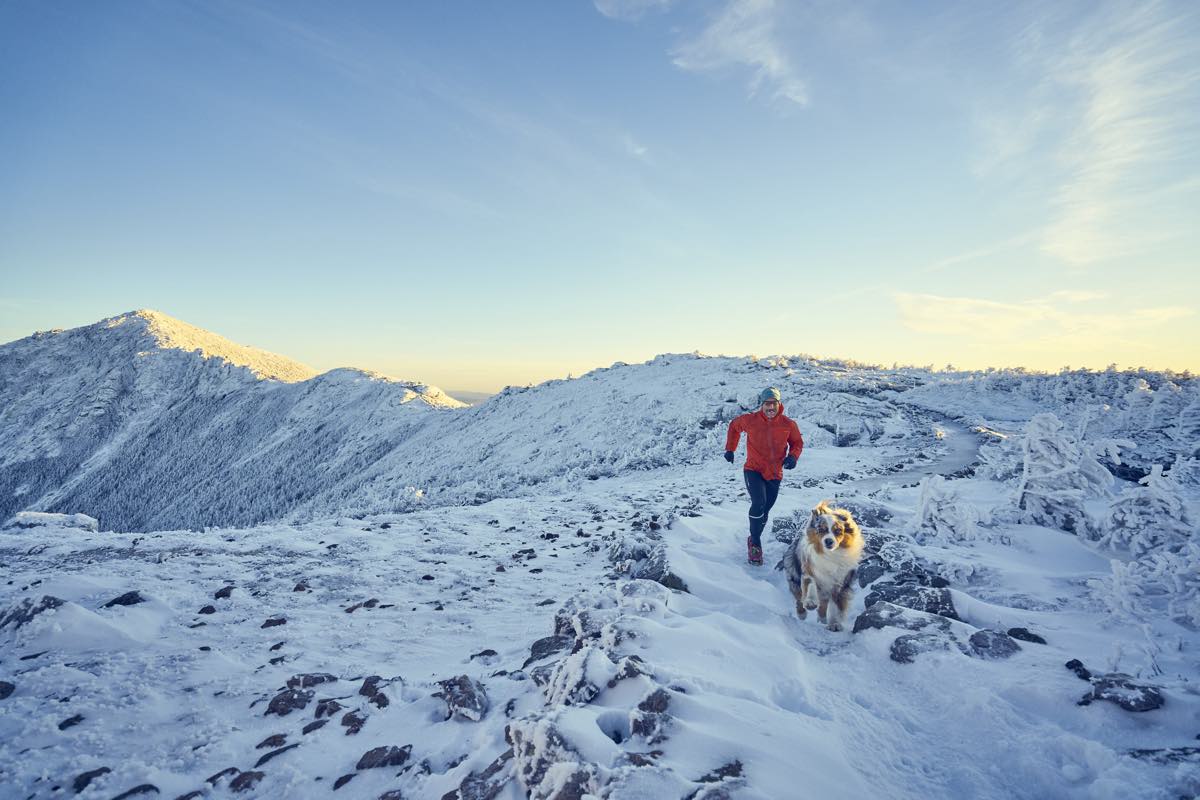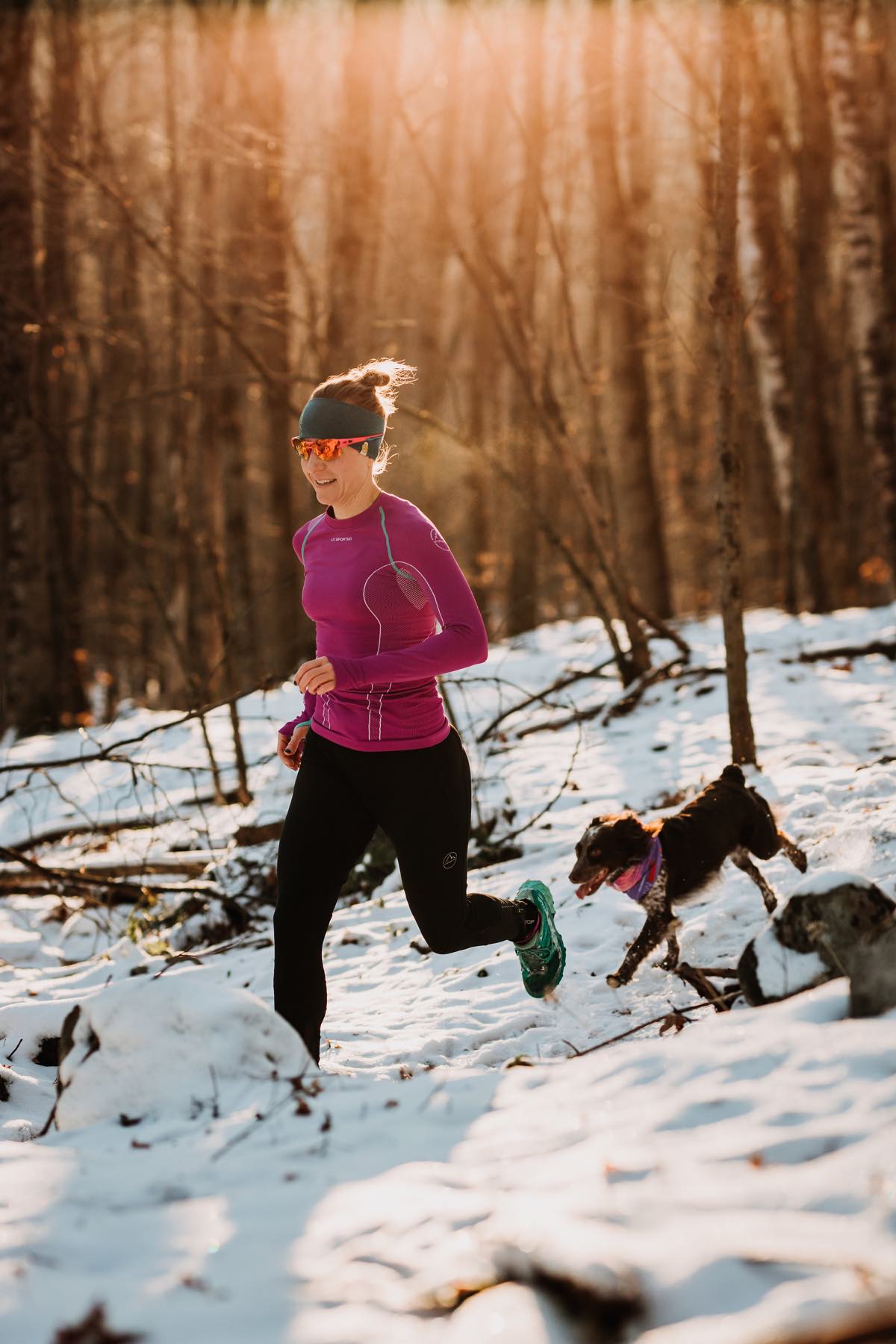As I don my running clothes, prepare my pack, and put on my shoes, she begins to stir. Pacing back and forth in a tight pattern just a few feet in front of me, Twig knows that her presence cannot be overlooked. I move from one room to another, gathering small, forgotten, last-minute items. All the while, I have a shadow. She has no intention of letting me out the door without her. I then ask my two-year-old Border Collie mutt, “Twig, wanna’ go for a run?” It’s a question I already know the answer to, but I ask as part of our routine and to let her know it is time. Her reaction is always the same and it makes me crack a goofy grin. She does a low-to-the-ground bow with her hind end raised high in the air and her forearms and chest pushed toward the floor–this is the downward-dog yoga pose, canine-ified. This is accompanied by a vocal exhale, seemingly relieved that I have finally asked the question.
Heading to the trail, she never asks about the weather, our route, or how far we are going. She just goes, with no hesitation or fear. As I bend down to unhook her leash, I get a big kiss on the check that draws up into my eye. I give her the word “fly” and she takes her first strides down the trail with what has to be uninhibited joy. It has become our routine day after day, although as the frequency and duration of our runs together have increased, I have come to the realization that I needed to learn more. It seems that my dog is no longer just a running companion, but rather she is transitioning into an athlete. I had questions about how to keep my athlete dog healthy.
During our run, would sips of my electrolyte drink and bits of my gels and bars fuel her properly? For recovery, I questioned if she needed a snack with the same carbohydrate-protein ratio recovery formula that humans use. How much could she safely run on a given day and throughout the week? Would I know if she wanted or needed a day off? I looked to the Internet for guidance, but struggled to find sound information, so I turned to my veterinarian, Dr. Ryan Canales. He was kind enough to answer some questions for me. Here goes.
***
Aliza: At what point does a dog become an athlete?
Dr. Ryan Canales: That is a good question as outdoor enthusiasts are becoming more and more engaged with their four-legged companions. This encompasses anything from agility, frisbee, hiking, mountain biking, field work, law enforcement, and the list goes on and on. Dogs participating in these activities or any activity that involves a skill set or repetitive training would be considered a canine athlete. These increased demands on household dogs can take a toll both physiologically and anatomically, therefore their energy needs and other physical requirements need to be paid attention to more so than the everyday companion.
I suggest that if you want a dog for ultrarunning endurance, pick a breed that can do the activity. Also take into consideration the weather spectrum that your region sees, along with the terrain on which you train. Common sense usually goes a long way when picking a dog, but I was proven wrong skinning Gulf of Slides on Mount Washington three years ago when a puggle passed me on the way up!
Aliza: Do dogs and humans have the same aerobic capacity?
Dr. Ryan Canales: Animals are quite different from humans when it comes to aerobic capacity. Even the untrained dog has a considerably higher VO2Max then an Olympic athlete. Many times sled dogs are used in research to test the power house of the physiological system called mitochondria. Dogs can have as much as two to three times the VO2Max of a human, considering well-trained, world-class athletes can range from 80 to 90-plus milliliters of oxygen per kilogram of body mass per minute.
Dogs are not much different than humans in the way they still need carbohydrates to fuel the Krebs cycle to burn fat, but because they have so many mitochondria, they are much more efficient in burning fat. It is also known that dogs that are rested for months in their off season can then come back to running multiple miles a day much faster than a human because the number of mitochondria remains relatively the same without exercise. This also allows dogs to be able to increase the amount of exercise at a more rapid rate compared to humans.
Aliza: Do canine athletes have special dietary needs?
Dr. Ryan Canales: Canine athletes have much different energy requirements than human athletes. Many human athletes rely on a high-carbohydrate diet because they increase muscle glycogen, but in dogs they have the reverse effect. Because of the number of mitochondria that dogs have, they are very efficient machines and can burn fat as energy. Diets that are more beneficial for athletic endurance dogs requires roughly 20 to 22 percent fat on a dry-matter basis, 30 to 34 percent protein, and 50 60 percent carbohydrate.
Aliza: Should dogs be given the traditional runners’ gels, drinks, or bars? Why or why not?
Dr. Ryan Canales: Yes and no. This can be a loaded question because each individual dog can have different needs, just like a human. You can use the human products, but you need to be careful of the electrolyte content. This can cause digestive upsets, the same way as people. Again, this is not cookie cutter for all dogs, but roughly one gram/kilogram of body mass/hour of carbohydrate is a good number to start with when considering how much a dog can take in to keep the furnace running.
I personally use a product called Glycocharge that I mix into a paste or add to the dog’s water. You can carry this with you in Ziploc bags. Some people use Karo syrup as well. I will also use Yaff Bars, which are made for human and canine consumption. Again, just be careful as with people, dogs need to become accustomed to this and what works for one may not work for another.
Aliza: Any advice on hydration for exercising dogs?
Dr. Ryan Canales: You should make sure that there is plenty of fresh water available. I carry a CamelBak just for the dogs if I know that fresh water, like streams or other bodies of water, will be minimal. Glycocharge will help dogs drink that don’t seem interested while panting. On the other hand, it is horrible for their teeth, like gels are for our teeth. (Make sure you brush your dog’s teeth on a weekly basis.) Sometimes, just stopping and encouraging your dog to take the time to drink and cool off can help them feel less apprehensive and less rushed.
Aliza: Should a canine athlete eat following a training session like a human athlete?
Dr. Ryan Canales: Absolutely, the quicker you get food into them to replenish glycogen reserves, protein, and fat for recovery, the better they will be to go again the next day and the next. High-density, high-calorie foods are much better than low-calorie foods as you feed much less. Look for a diet that contains roughly 500 calories per cup. They do exist. Also no different than a human, you would like to get some calories into your canine within the 30-minute window.
Aliza: Are there signs/symptoms that would alert an owner that their dog is over-exercising or not getting the right nutritional intake to support their energy expenditure?
Dr. Ryan Canales: An endurance canine is going to look much different than a typical house dog that goes for short walks. Many people will tell you your dog is too thin. We use the Body Conditon Scores (BCS) scale that ranges from 1 through 9. On this scale a 1 is emaciated and a 9 is obese, and athletic canines I like to see at a 4. Please understand this is breed specific and that the BCS scale is subjective.
One condition owners should be aware of is exertional rhabdomyolysis. This condition can occur in dogs that are not conditioned properly and can be seen in athletic and working breeds. It can be life-threatening and it results from a dog overworking to the point that their muscles become damaged on the cellular level. Signs to be on the lookout for are if your four-legged friend is unwilling to go for a run, over-sleeping, has brown-colored urine, a sluggish gait, tail drooping, stiffening up while out running, and the list continues. Most importantly, if your dog seems disinterested in something they usually enjoy, take this as a serious warning sign and consider seeing your veterinarian.
Aliza: Is mental exercise just as important as physical exercise for dogs?
Dr. Ryan Canales: Absolutely, dogs that are doing something repetitively can become extremely bored or just don’t want to do it any more. They need a mental break. The most important take-home message is, keep it fun. Like people, we are rewarded by satisfaction/gratification. When we are not satisfied any more, we tend not to be as good at what we are doing. Example can be when conditioning a dog. Most dogs that are running 50 to 100 miles a week love it, but if not conditioned properly they may quit or become injured. These are signs of over-exercise, too. Just remember that endurance dogs should have some down time, too, just like their athletic owners. Remember they recover much quicker than humans mentally and physically, but also beware as your dog maybe ready way before you are! Also to keep things fresh, remember that your canine-athlete friend can take up other sports to break things up a bit, like backcountry skiing, hiking, and practicing commands and learning new ones is also a great way to help work your dog mentally and physically.
***
To date, Twig’s longest run has been 26 miles with over 10,000 feet of ascent. She has shown she can go further and faster, but for now we are trying to keep a balance of mental and physical activity. Between my husband and I, we have taken her all over the place skiing, biking, hiking, and running. Unfortunately, she has yet to find her love for the water, but we will keep trying to encourage swimming. Nonetheless, no matter what the endurance adventure, I have found that the best way to keep her fueled is to feed her snacks whenever I eat, which is typically every 30 to 40 minutes. Her favorite on-trail snack seems to be salmon jerky with a smear of peanut butter. She and I are also big fans of Yaff Bars as we can share them, which keeps packing simple.
In the beginning, I griped about carrying the extra supplies, but now I have made it common practice to carry extra water for her along with ample snacks. I just tell myself that the extra weight will make me stronger and keep her healthy and able to accompany me out on the trail for years to come.
Day after day, I am excited to plan adventures where Twig and I can explore. No matter how muddy my little mutt gets or whether she eats her portion of calories and part of mine, having her as a companion on and off the trail has been a gift. Sometimes I call my canine athlete a curse, but that is just because she frequently and elegantly out endures and outwits me. It surely has been a learning process going from a household dog to a much more athletic dog, but with the help of Dr. Ryan, we have made great progress.
Call from Comments (from Meghan)
- If you’re the owner of a trail running dog, what have you learned about keeping your pooch happy and healthy on the trails?
- Do you have any live-and-learn stories about what hasn’t worked for your dog in terms of food, hydration, heat, cold, and other health issues?


